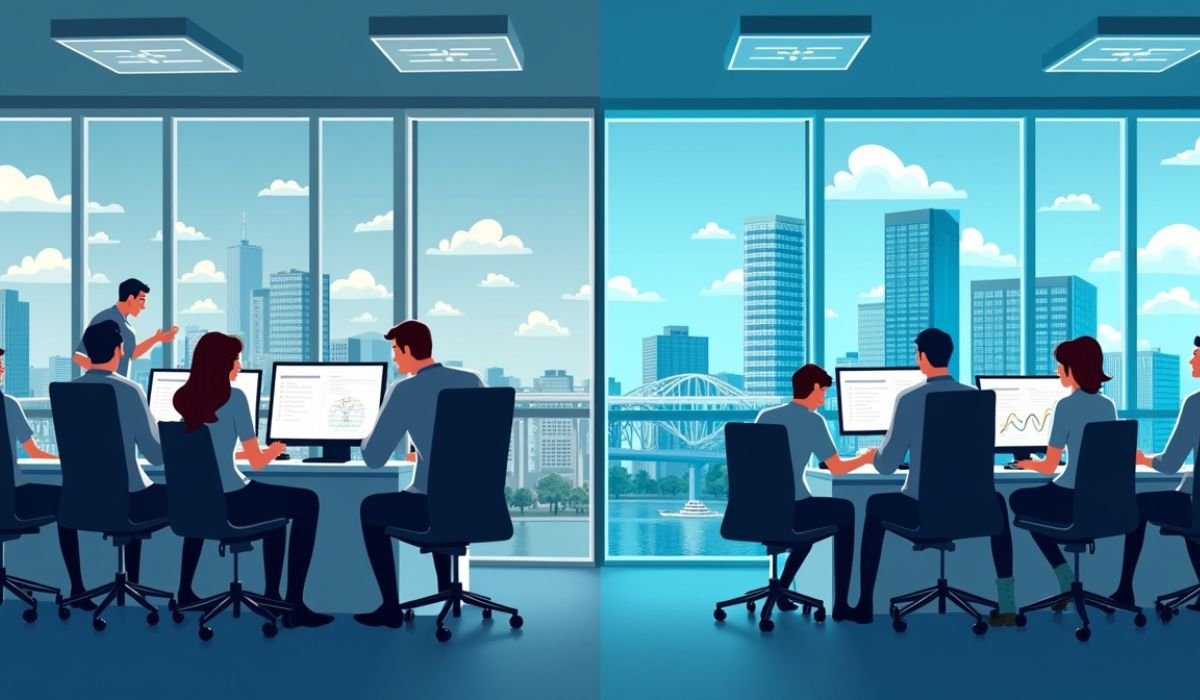Training Through Play: VR Developers Transform Learning
Key Highlights
- Virtual reality (VR) training is changing the way people learn. It uses ideas from making games, like telling stories and getting users to join in.
- This immersive learning way is more engaging and works better. It helps you remember things for a longer time compared to older learning methods.
- VR gives you a safe place to practice. You can try high-stakes tasks with no risk and not worry about making mistakes in real life.
- Many industries, like healthcare and manufacturing, now use VR for training. They use it to teach tricky procedures, safety rules, and soft skills.
- VR simulations also give businesses clear data. They can see how well their people are doing and track skill development in a accurate way.
- The first cost of VR and learning how to use it can be hard. But most see that the benefits of VR training, like better retention rates and learning, are worth it in the long run.
Introduction
The way companies train their workers is changing. It is no longer just about old lectures and manuals. Game developers are now leading this change. They use their know-how in storytelling and design to shape how people learn at work. Because of this, we now have powerful virtual reality (VR) training tools. These create real, hands-on lessons where people can learn by doing. VR training gives a new level of immersive learning that people did not have before. In this guide, you will see how these fun technologies are shaping skill development in many fields.
The Evolution of Training: From Traditional Methods to VR
For a long time, people had to learn in classrooms or from books. Traditional training methods were the main way to teach new skills. But these old training methods often had trouble keeping people’s attention. They also did not give much real, hands-on experience. In a normal training program, you could watch and listen, but you did not get to do much yourself. This way to learn did not work well for everyone because there was not enough active participation.
Now, VR technology is changing how we learn. This new technology gives a new kind of training environment. Here, you can step in and interact with everything around you. So, you do not just read or listen about what to do—you really get to try it in a safe, virtual place. With VR, training programs help people learn by doing. There is more active participation than before. Next, let’s look at what made traditional training hard and what makes this new way of training better.
Limitations of Conventional Training Approaches
Traditional training often does not get employees interested or involved. Some ways, like talks and slides, make learning too quiet and slow. People may not remember what they learn. This way the team learns is also hard for managers. They must pay for trips, rooms, and teachers. If teams are big or far apart, it gets more trouble. How good the training is may change too. It can depend on how good the teacher is.
These old training methods do not always show a real learning environment. People cannot learn what to do in a risky moment just by reading. If you need ways for training purposes that deal with danger, you need space to try out the skills. There is always a big hole between what you know in theory and what you do out in real life.
Without practice, there is less chance to grow true skill development. Workers may get it with their minds but do not have the feel in their body. They may not act well or with trust when it matters. Traditional training often does not give a safe place to try, make mistakes, and get better. This is key for tough skills.
The Rise of Virtual Reality in Learning Environments
Virtual reality solves the problems of old training methods by giving people a fully interactive virtual environment to use. With this new technology, learners can step into a simulation and do tasks just like they would in the real world. They do not just sit and listen. Now, they join in, which helps them stay interested and focused for a longer time.
This move toward immersive learning is what makes VR special. When you use VR technology, hard ideas become easy to see. Complicated tasks become easier to do. For example, a new surgeon can repeat a tough surgery many times with no risk to their patient. This “learning-by-doing” style helps people feel more sure of themselves and get better at their work, much more than just reading about it in a book.
The growth of VR is a big change in how people learn and get new skills. It offers a way to train that is easy to use for many people, always the same, and really works well. Now, organizations can make strong learning experiences that anyone can reach, no matter where they are.
What Is VR Training and How Does It Work?
VR training is a way to use computer-made worlds to copy real life for learning. With VR headsets, you go into a 3D space where you can touch and work with things and people. This lets you have a deep and immersive learning time.
This kind of tech helps you learn by doing the task yourself. You do not just hear about things—you get to try them out in a safe place. This makes it easy to build muscle memory and to feel sure when you do the task for real. It helps you move from just knowing to doing, which is what experiential learning is all about with VR.
Core Principles of Virtual Reality Training
The way VR training works comes from a few main ideas that set it apart from other ways people learn. This immersive technology matches how the brain likes to take in and remember new things. It does this by making you feel like you are really in a different place. When you are in that spot, your mind is sharp, and you remember what you learn much better.
One big piece of this is called experiential learning. So, in VR, you do not just watch—you get to act. You make choices and do things that have meaning inside the virtual world. Because you get to make these choices, the things you learn stay with you much more than if you just watched or read about them.
This way of virtual training works well because it uses a few simple but important ideas:
- Presence: It makes you feel like you are truly there in the environment. This helps you block out other things and pay full attention.
- Safe Failure: You get to try things and mess up with no real-life problems. This makes it okay to try new ideas and helps you really get it.
- Repetition: You can do the task over and over. Each time you practice, you get better and remember more.
- Immediate Feedback: You get help and answers right away when you mess up or need a hint. That way, you can fix things while you learn.
This makes VR training
Key Differences Between VR, E-Learning, and In-Person Instruction
Choosing the right training method depends on your goals, budget, and the skills you need to teach. While in-person training offers direct interaction and e-learning provides flexibility, VR combines the best of both worlds with a unique, immersive learning experience. For VR learners, the engagement level is significantly higher because the virtual environment commands their full attention.
This heightened engagement directly impacts retention rates. Studies consistently show that we remember more of what we do compared to what we see or hear. A PwC report found that VR-trained employees learned four times faster than their classroom counterparts
Here is a quick comparison of the three methods:
| Feature | In-Person Training | E-Learning | VR Training |
| Engagement | Moderate to High (instructor-dependent) | Low to Moderate (passive) | Very High (immersive) |
| Retention | Low (lecture-based) to Moderate | Low to Moderate | High to Very High |
| Safety | Risky for hazardous tasks | Not applicable for practical skills | Completely safe and risk-free |
| Scalability | Low (logistically complex) | High (easily distributed) | High (once content is created) |
Game Development Meets Education: The Power Behind VR Training
The real magic of good virtual reality training is not only in the hardware. The software is what makes it great. The best immersive learning solutions use skills that make video games fun, like storytelling, interactivity, and changing environments. VR Game developers have what it takes for this kind of content development.
When these ideas are used, a training program becomes more than a simple list of things to do. It turns into an experience. This grabs the interest of people and gives them a reason to do well. The method works well for teaching things that are hard to learn or talk about, like soft skills.
Storytelling and Narrative Techniques in VR Learning
Effective storytelling is a strong way to help people learn, because it gives the information meaning and helps us feel something about what we learn. In immersive learning solutions, using a story helps guide a person through a situation, showing the goals and problems as part of a big, important story. This makes the training stick in your mind more, so you remember it better than just reading a list of steps.
When you enter a virtual world that has a clear story, you do not feel like a person just training. You become the main person in the story who must deal with a big task. For example, you might be a doctor getting ready for an important surgery or a leader learning how to fix team problems. The story is what keeps you interested because it shows why what you are learning matters.
This way of teaching turns the training environment into a place where people solve problems actively. When a VR lesson is made with a story in mind, developers get to teach tough skills like leading others or talking with people the right way. The story asks you to handle real social things so you can learn and grow in new ways.
Real-Time Interactivity and Its Impact on User Engagement
Real-time interactivity is what makes people want to stay and keep using vr training. Instead of sitting back and just listening, you have to do things in VR. You might pick up a tool or pick what to say to someone, and you get to see what happens in the simulation right away. This type of hands-on learning experience keeps you on your toes. You have to make choices and pay close attention. Because what you do makes a difference, you really start to think about the task you have to do. This level of active participation makes vr training feel less like a simple lesson and more like something you would face in real life.
This kind of interactivity makes a big difference when it comes to getting people involved. The most important things include:
- Direct Manipulation: You get to move and use virtual objects with your own hands.
- Responsive Environments: The world in vr changes and reacts to every move you make.
- Branching Scenarios: What you decide to do changes what happens next in the story.
- Instantaneous Feedback: You get results right away, which helps you learn the right steps and quickly fix errors.
Benefits of Virtual Reality Training for Businesses
The benefits of VR training are not only about keeping people interested. When businesses use VR in their corporate training, they can get big gains in how fast things get done, how safe workers are, and the overall way that people do their jobs. If you build a good VR training program, it will help make your workers more skilled and give them more confidence. This kind of training can really pay off over time.
One big reason to use VR training is because it helps people remember what they learn better. They do not just store facts in their mind. Instead, they get to try things out and build real skills. This next part will look more at these important benefits of VR, and how a VR training program can help lower risks and boost retention rates in corporate training.
Improved Engagement and Retention Rates
One of the biggest benefits of vr training for corporate training is that it helps your team pay attention. This kind of immersive learning cuts out distractions, so people remember much more than with traditional methods. When you are using a vr simulation, you are focused. The training you get is more likely to stay in your mind.
With vr training, the learning experience gets better and shows real results. There was a study done by the University of Maryland. They found people remembered information better when it was in a VR environment than when it was on a normal screen
The success of vr is clear in both research and normal work life:
- Faster Learning: A PwC report says vr learners finished training up to four times faster than people in a normal classroom.
- Higher Confidence: The same report found vr learners felt 275% more confident with their skills after doing the training.
- Increased Recall: Sprouts Farmers Market said their team was 16 times more likely to remember the training if it was in vr.
- Improved Performance: Nicklaus Children’s Hospital raised retention rates for medical procedures from 20% with traditional methods to 80% with vr training.
Enhanced Safety and Risk-Free Practice Opportunities
VR training gives people a safe way to learn and practice jobs that could be dangerous. With vr training, employees try out tasks in a vr safe environment. They can make mistakes and learn from them without any real risk. This is important in fields like manufacturing, construction, and healthcare, where one wrong step can cause big problems.
Think about a worker who has to fix a high-voltage machine, or a firefighter learning how to get through a burning building. With VR, they get to practice in a way that does not put them or anyone else in danger. This lets people learn the skills they need and build up their confidence to deal with tough situations.
Companies use vr training because it boosts workplace safety. When workers know what to do before they start, accidents and injuries go down. For example, in mining, using a vr safe environment for training helped cut down risky mistakes by 43%.
VR for Soft Skills: Communication, Teamwork, and Leadership
Beyond technical training, VR can also help people build soft skills. Things like communication, teamwork, and leadership are hard to teach with books or in the classroom. These skills are best learned with real practice and feedback during social situations.
Immersive learning is great for this. With VR, you can take part in tough workplace talks, work out problems with a team, or practice public speaking. This gives you a safe and private place to practice your skills and get honest feedback.
Immersive Scenarios for Workplace Social Skills
VR is great for making real-life situations where people can work on their social skills. You can be put into places or moments with VR that are hard to make happen in normal role-playing. For example, you might talk to an upset customer or try to give feedback to someone you work with. Being able to practice these moments helps people feel more sure of themselves in many work talks.
With VR, you get chances to practice talking to crowds and work better with other people at your job. You can do these actions over and over. Because it feels so real, what comes up in you also feels true. This helps the learning stick.
You can also make these VR scenarios fit what you need:
- Conflict Resolution: Get good at hard talks with virtual people that act in new ways depending on what you say and how you say it.
- Leadership Training: Take on the lead role and guide a team through tough times.
- Diversity and Inclusion: See things from many points of view to understand people better.
- Customer Service: Work with all kinds of customers, from nice to rude, and deal with their problems in a safe space.
VR is useful to help practice public speaking and helps people get ready for what’s real at work.
Measuring Performance Improvements through VR Simulations
One big benefit of VR simulations is how they collect lots of data on what people do. The training program gets real numbers about how people improve and how their skills are growing. It does what traditional training can’t, tracking all choices, moves, and even hesitations as people use VR.
With this data, you can see just how someone is getting better. The training program shows if they look at the right spot during safety checks or if they use the right tone when talking about tough topics. VR tracks these small but vital actions and gives feedback anyone can use to get better faster. It helps everyone hold onto new knowledge.
Training is not just a one-time thing now. It becomes something people keep working on. With VR, managers see where people are doing well and know where they need help. The detailed numbers from these sessions show that the training program truly works. The training clears up skill development and knowledge retention and the company is sure people can use what they learn in real life.
Industry Use Cases: VR Training Transforming the Field
The use of virtual reality for training is not just an idea for the future. It is be used in the real world right now. You can see many industry use cases where this new technology is helping solve big problems for businesses. People, from doctors to store employees, are using a better training program and getting real benefits.
Companies use VR because it makes work safer, helps people learn hard skills, and makes daily tasks easier. The stories below show how many different jobs are now using immersive training for real, solid results. These prove that VR is a strong and useful tool that helps today’s workers get better in many ways.
Healthcare: Patient Care and Surgical Training
In healthcare, VR is changing how medical training works. Surgeons now use a virtual environment to practice hard procedures. They can get better skills without risking any patient. Studies show that surgeons who use VR for training make fewer mistakes. They also improve their performance by over 200%.
The technology lets medical personnel go over different tasks. People can rehearse things like putting in an IV, taking care of wounds, or even doing rare surgeries. Repeating these jobs in a simulation helps you build muscle memory and makes you more sure of yourself. This is important when someone’s life might be at risk.
VR is not just for surgery. It helps with training for patient talks, emergency routines, and how to use complex medical machines. The virtual environment gives a deeper way to learn. It helps healthcare workers get more ready for real-life jobs that can be stressful. This leads to better care for patients in the end.
Enterprise Safety and Compliance Simulations
For a lot of businesses, enterprise safety and compliance are very important. VR can help a lot with these training purposes. It lets people take part in real-life scenarios without any risk. Employees can learn to spot dangers, follow emergency steps, or use heavy machines the right way.
Immersive learning makes safety lessons stick in your mind. When you go through what happens if you break a rule, you see why safety matters even more. This works better than just reading a manual or watching a video.
Many companies in areas like manufacturing, energy, and construction use vr to lower work accidents. They let people practice in a safe setting so everyone knows what to do if something bad happens. This protects both the workers and the business.
Corporate Onboarding and Professional Development
The onboarding process is an important time the new employees get to learn about what they will do and see what the company culture is like. VR helps with this by giving people a way to really feel what their new workplace is about. Walmart uses VR so the new employees can get ready for the busy Black Friday rush. They get to know what it is like before the big day comes.
VR also helps make professional development faster and better. Instead of just hearing about how things work, you get to try out your skills in real situations. At Pfizer, they used VR so workers could learn new ways to make things. This made people learn tasks almost 40% quicker and helped them make more vaccines when it was needed most.
So, these things show how VR lets the new employees fit in faster and pick up new skills fast. You get a training session that is always the same, easy to share with more people, and fun to use. It helps set up the first day to be good for everyone.
Conclusion
VR training is changing how we learn and build skills. It uses game design ideas like stories, interaction, and live settings. This helps people stay interested and remember what they learn. VR solves problems that come with traditional training methods, giving everyone a safe place to try things out with no risk. Many businesses see better results, mostly in skills like talking with others and working as a team, which are soft skills. When you look into vr training for your company, think about how it can help with skill development and improve how people learn. If you want to know more about vr or want to try it, you can get in touch for a free talk about it.
Frequently Asked Questions
Is VR training more effective than traditional methods?
Yes, vr training often works better than traditional methods. It uses an immersive learning way that helps people pay more attention and remember things better. You get to practice in a training environment that feels real. This will help you get the skills faster and know them deeply. With vr, you have a good chance to keep what you learn because of higher retention rates.
What does a business need to get started with VR training?
To begin, a business needs VR headsets, VR hardware, and a software platform that helps manage these devices. There should also be a training program with content that fits what people need to know. The company will need to make an initial investment at first, but it gives your team the power of immersive learning.
What industries benefit most from VR-based learning?
Many high-risk industries get a lot of help from using VR. One area is healthcare, where it helps with medical training. In manufacturing and construction, it keeps people safe at work. Pilots use it to practice flying safely. It is also useful for corporate training. This training can help people in any field to develop soft skills. VR makes learning safer and better in these areas by letting people practice real situations without risk.
READ ALSO: Upgrade your manga experience with the top ComicK replacement











